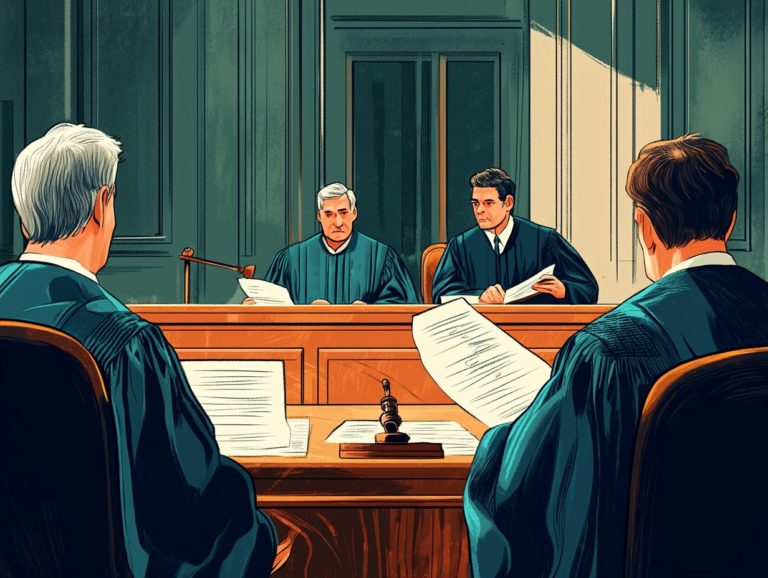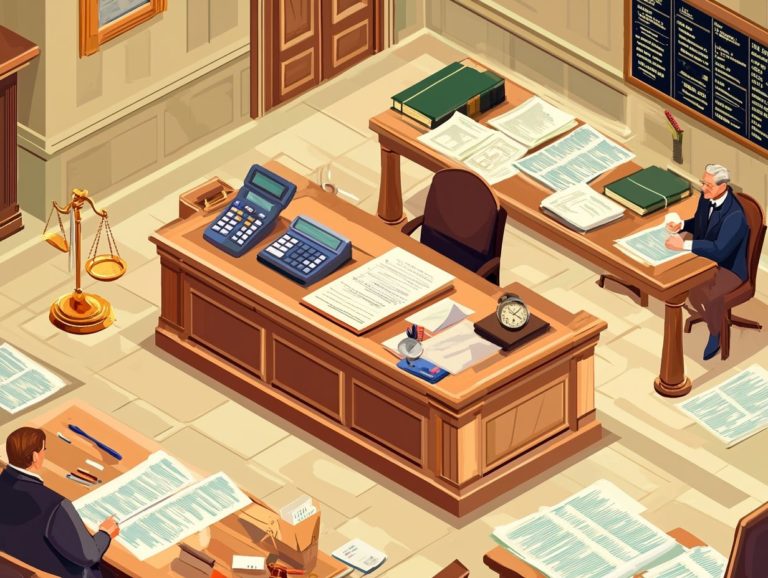10 Landmark Cases in IP Litigation History
Intellectual property (IP) plays a vital role in innovation and creativity, shaping how your ideas, inventions, and brands are protected in today s competitive landscape.
This article delves into ten landmark cases that have significantly influenced IP law, ranging from the groundbreaking Diamond v. Chakrabarty to the pivotal Oil States Energy Services case.
You ll also find a comprehensive explanation of the fundamentals of intellectual property, the various types available, the litigation process, and effective strategies for safeguarding your creations.
Embark on this journey with us as we navigate this intricate legal terrain and uncover the profound implications of these landmark decisions.
Contents
- Key Takeaways:
- 1. Diamond v. Chakrabarty (1980)
- 2. Sony Corp. v. Universal City Studios (1984)
- 3. Lotus v. Borland (1996)
- 4. eBay v. MercExchange (2006)
- 5. KSR International Co. v. Teleflex Inc. (2007)
- 6. Alice Corp. v. CLS Bank International (2014)
- 7. Apple Inc. v. Samsung Electronics Co. (2016)
- 8. TC Heartland LLC v. Kraft Foods Group Brands LLC (2017)
- 9. WesternGeco LLC v. ION Geophysical Corp. (2018)
- 10. Oil States Energy Services LLC v. Greene’s Energy Group LLC (2018)
- What Is Intellectual Property and Why Is It Important?
- Frequently Asked Questions
- What are the top 10 landmark cases in IP litigation history?
- What is the significance of the Diamond v. Chakrabarty case in IP litigation history?
- How did the Sony Corp. v. Universal City Studios case impact copyright law?
- What was the main issue in the eBay Inc. v. MercExchange LLC case?
- How did the Alice Corp. v. CLS Bank Int’l case impact software patents?
- What was the outcome of the Apple Inc. v. Samsung Electronics Co. case?
- How did the TC Heartland LLC v. Kraft Foods Group Brands LLC case impact patent venue laws?
Key Takeaways:
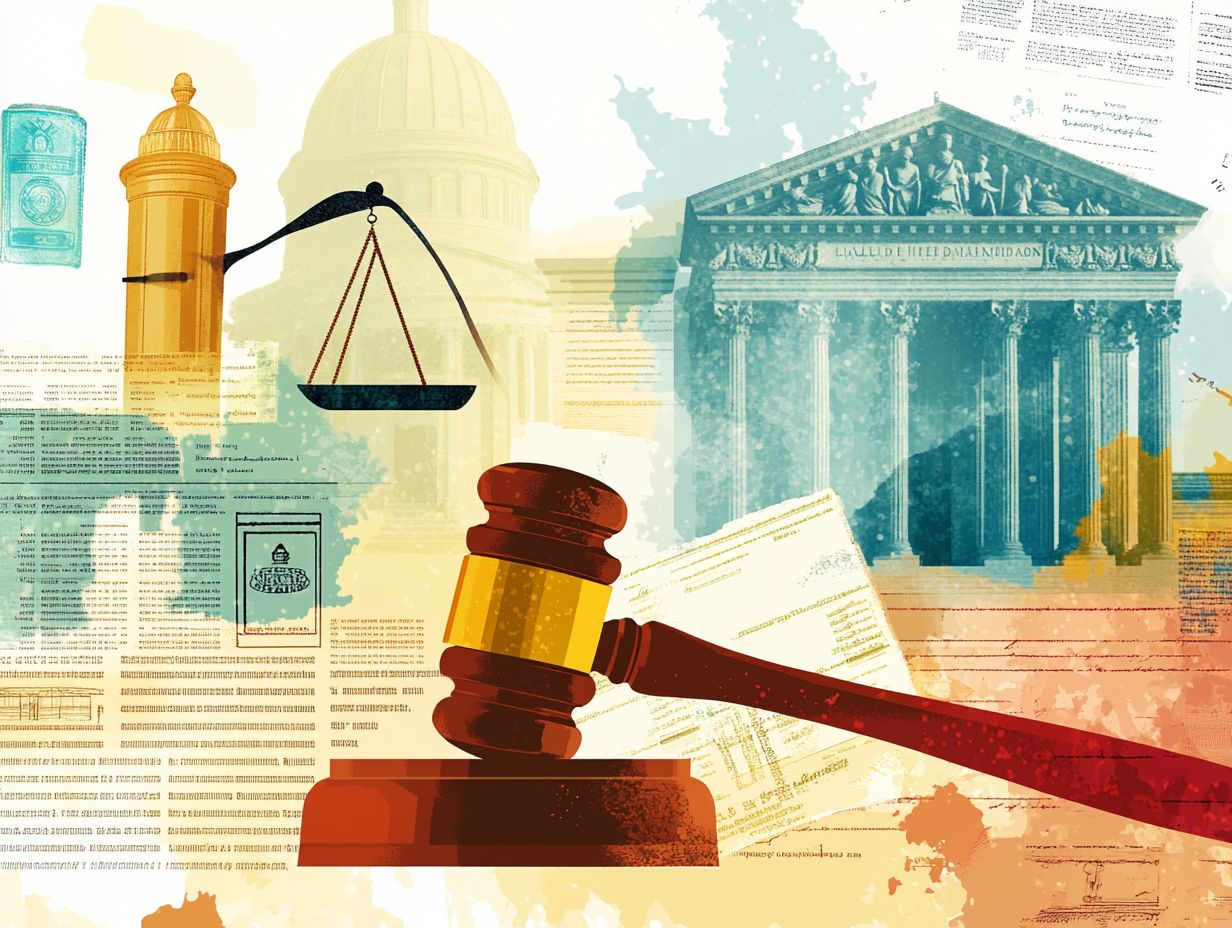
Diamond v. Chakrabarty (1980): This case established that living organisms can be patented, paving the way for biotechnological innovations.
Sony Corp. v. Universal City Studios (1984): This case established the concept of fair use for copyrighted materials, allowing consumers to record shows for personal use.
eBay v. MercExchange (2006): This ruling determined that an injunction may not be automatically granted in patent infringement cases, balancing the interests of patent holders and defendants.
1. Diamond v. Chakrabarty (1980)
The landmark case of Diamond v. Chakrabarty in 1980 fundamentally reshaped the landscape of intellectual property law by addressing whether genetically modified organisms could be patented. This decision has had lasting implications for damages and innovation in the biotechnology industry, as highlighted in the 5 lessons learned from major IP litigation cases.
This pivotal case emerged when a microbiologist sought patent protection for a genetically engineered bacterium capable of breaking down crude oil an important innovation amid rising concerns about environmental pollution. The patent office initially rejected the application, arguing that living organisms were not eligible for patents.
However, in a groundbreaking ruling, the Supreme Court decided in favor of the applicant, asserting that any invention providing a new utility, even if it involves a living organism, can be patented. This decision opened exciting new doors for patent protection in biotechnology!
This ruling expanded the scope of patent protection in the biotechnology sector and set a significant precedent for future cases related to genetic innovations, fostering increased investment and research in life sciences.
Advocates and critics alike recognized the ruling s potential to drive technological advancement while raising ethical concerns about the commodification of life forms a debate that continues to resonate today. Curious how this affects today’s innovations? Let’s dive deeper!
2. Sony Corp. v. Universal City Studios (1984)
Sony Corp. v. Universal City Studios (1984) stands out as a pivotal moment in copyright law, tackling the legality of home video recording while shaping the rights of artists and companies within the entertainment industry.
This case emerged during the rise of video cassette recorders (VCRs), which enabled consumers to record their favorite television shows for personal enjoyment. Universal City Studios argued that this practice infringed upon their copyrights, claiming it threatened the commercial market for their films.
Conversely, Sony championed the VCR, highlighting its numerous beneficial uses, such as time-shifting allowing viewers the flexibility to enjoy content on their own schedules. In a significant ruling, the court ultimately sided with Sony, determining that home recording for personal use did not violate copyright laws.
This landmark decision not only reinforced consumer rights but also established a precedent for future technology, paving the way for increased protection for artists and encouraging an evolving commercial landscape in entertainment, as highlighted by notable figures in IP litigation history.
3. Lotus v. Borland (1996)
The 1996 case of Lotus v. Borland brings to light crucial issues surrounding trademark rights and software copyright, prompting you to reconsider the delicate balance between technological innovation and intellectual property protection under federal law.
In this legal showdown, the central question was whether Borland’s use of Lotus’s menu command structure infringed on trademark rights, igniting a debate about which elements of software are eligible for protection.
The court’s ruling highlighted the complexities of distinguishing between innovation and infringement in an industry that thrives on adaptability. As technology evolves at breakneck speed, the repercussions of such cases not only establish precedents for future software rights litigation but also shape how companies navigate the often murky waters of intellectual property, as seen in 5 famous patent cases that changed the law.
This scenario underscores the pressing need for a comprehensive legal framework that evolves alongside the relentless pace of technological advancement. Explore how these cases continue to influence the tech landscape!
4. eBay v. MercExchange (2006)
The eBay v. MercExchange case in 2006 was an important legal case that redefined the standards for granting permanent injunctions in patent cases. It fundamentally altered how courts address patent rights and enforcement.
In this landmark case, the Supreme Court examined whether a patent holder could secure an injunction against an infringing party by default or if they needed to consider specific factors like irreparable harm and public interest. MercExchange, the patent holder, argued that eBay’s auction platform infringed on its patents, while eBay countered that an injunction was unwarranted given the nature of the damages that could be awarded.
Ultimately, the Court sided with eBay, advocating for a more nuanced, case-by-case analysis regarding injunctions. This ruling dramatically changed the landscape of patent litigation, prompting courts to evaluate various factors before issuing injunctions.
As a result, it influenced numerous cases where the balance of interests in patent enforcement was contested, reshaping legal precedents and appeals in the years to follow, similar to 5 famous trademark cases that changed the law.
5. KSR International Co. v. Teleflex Inc. (2007)
KSR International Co. v. Teleflex Inc. (2007) marked an important moment in patent law, reshaping the standards of patentability and challenging the very definition of obviousness. This case dramatically changed the landscape for countless innovation claims across various industries.
This legal saga began when KSR contested the validity of Teleflex’s patent for adjustable automobile pedals. They asserted that the combination of existing technologies made the invention obvious. The Supreme Court ultimately sided with KSR, advocating for a broader and more flexible framework for assessing obviousness.
This ruling clarified the guidelines for evaluating patent applications and transformed how inventors and companies navigate the patenting process. Many in the tech sector are now more cautious, diligently refining their claims and thoughtfully considering the implications of this precedent in future patent disputes.
This encourages a more strategic approach to innovation and prompts a shift in how ideas are developed and protected.
6. Alice Corp. v. CLS Bank International (2014)
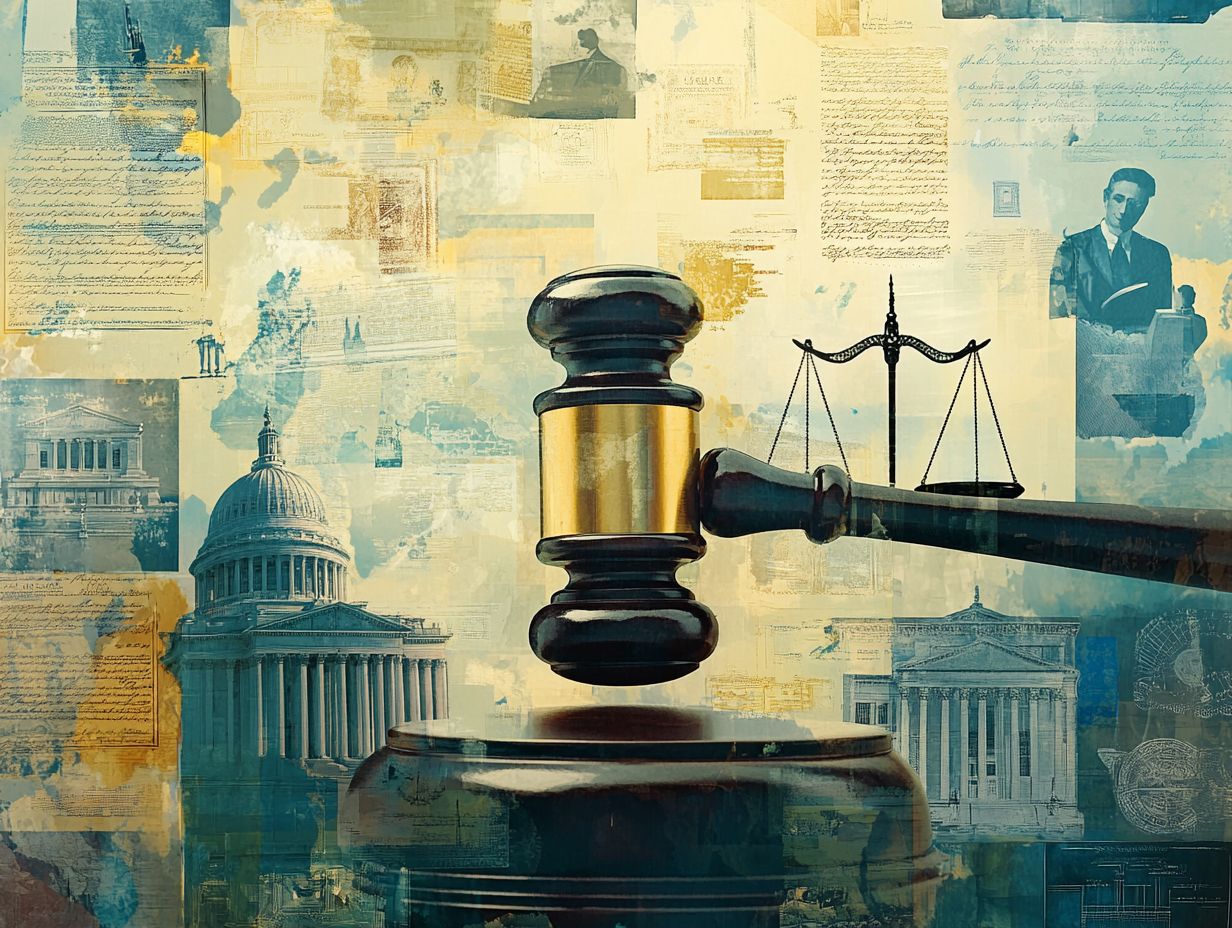
The Alice Corp. v. CLS Bank International case in 2014 had a profound impact on the legal landscape of patent eligibility, especially regarding abstract ideas and their technological applications.
In this landmark decision, the Supreme Court tackled the complexities of claims that simply implemented abstract concepts using generic computer technology. The court concluded that merely applying an abstract idea with a conventional computer component does not elevate it to the status of a patentable invention.
This ruling has significant ramifications for future patent applications, particularly within the tech industry. It raises the bar for securing patents on software and algorithms.
Now, as an innovator, you ll need to prove that your technological advancements extend beyond mere abstract concepts to obtain patent protection. This shift encourages more profound innovation and mitigates the risk of patent trolling, which refers to when a company uses patents mainly to threaten lawsuits rather than to protect genuine inventions. Ultimately, it fosters a more competitive and dynamic technology landscape.
7. Apple Inc. v. Samsung Electronics Co. (2016)
The high-profile litigation of Apple Inc. v. Samsung Electronics Co. in 2016 serves as a striking illustration of the fierce competition in the smartphone industry, particularly around patent infringement and the substantial damages that can result from such disputes.
In this case, Apple accused Samsung of infringing upon a series of design and utility patents linked to their smartphones, spotlighting features like rounded corners and the app grid layout. The court’s decision ultimately upheld several of Apple’s claims, resulting in significant damages that underscored the high stakes involved in intellectual property battles.
This ongoing conflict mirrors broader trends within the technology landscape, where innovation often nudges companies to the brink of legal boundaries. As Apple and Samsung vie for market dominance, the ramifications of their legal tussles extend far beyond mere financial penalties.
They influence future patent strategies and shape competitive practices in a rapidly evolving digital marketplace.
8. TC Heartland LLC v. Kraft Foods Group Brands LLC (2017)
The TC Heartland decision in 2017 transformed patent litigation venues. Now, companies can only be sued for patent infringement in their state of incorporation or where they have a regular place of business.
This change limits the legal advantages that plaintiffs once had in patent-friendly districts.
Many patent holders must now rethink their litigation strategies. They are shifting focus to jurisdictions that match their operations.
Defendants are in a stronger position to contest lawsuits in less convenient locations. This shift creates a more equitable environment for intellectual property disputes.
9. WesternGeco LLC v. ION Geophysical Corp. (2018)
In WesternGeco v. ION Geophysical, the court s ruling on damages for patent infringement revealed complexities in calculating lost profits.
The court found that the infringement harmed WesternGeco’s earnings both domestically and internationally.
This case highlighted the need for plaintiffs to show a clear link between infringement and financial loss.
The ruling established that lost profits can extend beyond U.S. borders, shaping future patent infringement lawsuits.
The implications for intellectual property law are significant. Companies must document sales and market presence to prepare for legal battles.
10. Oil States Energy Services LLC v. Greene’s Energy Group LLC (2018)
The Oil States case examined the constitutionality of inter partes review in patent law. This decision influences how you can challenge and defend patent rights.
The Supreme Court upheld the inter partes review process, raising questions about the validity of certain patents.
Supporters argue that this process is efficient for resolving disputes. However, some worry it infringes on patent holder rights.
This ruling can dramatically change how you approach patent litigation in the future! You must balance innovation with protecting inventor rights in a rapidly changing technological landscape.
What Is Intellectual Property and Why Is It Important?
Intellectual property (IP) covers the legal rights that protect your creations, including inventions, designs, and artistic works. IP plays a vital role in fostering innovation and creativity while shielding you from infringement and legal disputes.
Understanding different forms of IP like patents, copyrights, trademarks, and trade secrets is essential for creators and organizations. Each type protects unique ideas and products from unauthorized use.
For instance, patents give you exclusive rights to your inventions. Copyrights protect your artistic expressions. These rights encourage creativity and support economic growth, allowing you to enjoy the rewards of your efforts without fear of theft.
What Are the Different Types of Intellectual Property?
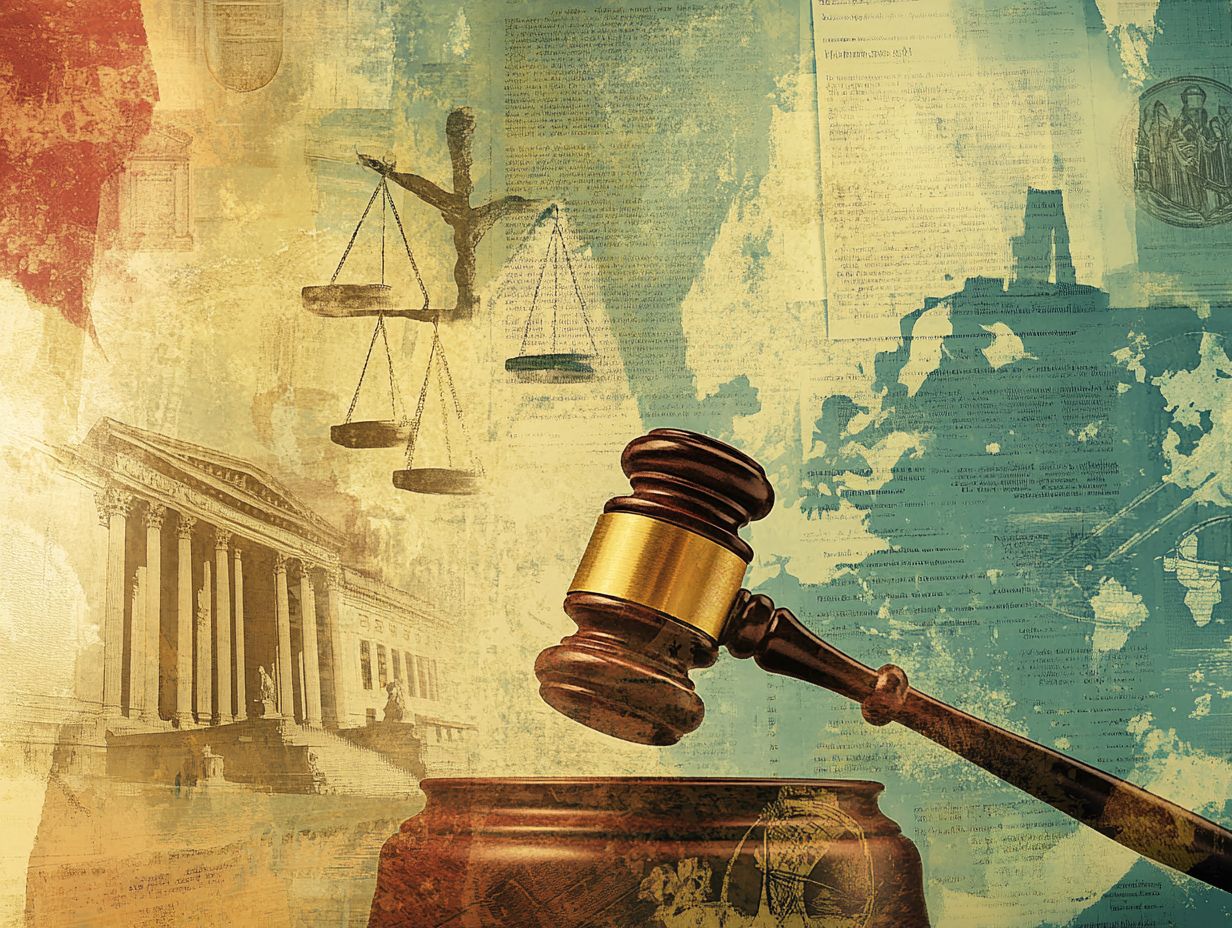
You ll find several distinct types of intellectual property, including patents, copyrights, trademarks, and designs. Each type is crafted to safeguard various forms of creative ideas and inventions.
Patents bestow exclusive rights upon inventors. This prevents anyone else from making, using, or selling their ideas without permission.
Copyrights protect the original works of authors, artists, and musicians. They allow creators to maintain control over how their creations are reproduced and distributed.
Trademarks safeguard brands by protecting distinctive symbols, names, or slogans. This enables consumers to easily identify goods and services.
Meanwhile, designs protect the aesthetic appeal of products. They ensure that unique visual aspects remain exclusive.
Together, these forms of intellectual property significantly contribute to economic development and enhance consumer trust.
What Is the Process of Filing an IP Lawsuit?
Filing an intellectual property (IP) lawsuit is a well-structured endeavor. It involves gathering evidence, filing claims, and understanding the legal process to safeguard your rights against infringement.
Before diving into the legal fray, it’s essential to explore prelitigation strategies. This allows you to assess the viability of your case and may involve negotiations or drafting demand letters. This preparation is crucial for your next steps!
Next, crafting a detailed complaint articulates your claims, identifies the parties involved, and provides the necessary factual context.
Gathering evidence becomes crucial as you proceed. It fortifies your position and strengthens your claims. Once the court process begins, having a robust legal strategy in place is vital.
Engaging seasoned representation can significantly enhance your chances of achieving favorable outcomes. It ensures that your rights are meticulously defended throughout the litigation journey.
How Do Courts Determine the Outcome of an IP Lawsuit?
The outcome of an IP lawsuit rests on various factors. These include the strength of the evidence you present, the applicable laws, and the court’s judicial review of your case specifics, similar to what was seen in 5 famous trademark disputes and their outcomes.
Beyond these foundational elements, the nature of the claims made by you and the opposing party can shape the court s decision-making process. Judges scrutinize the quality and relevance of the evidence you provide.
Legal precedents also hold considerable weight. Courts rely on established rulings to inform their interpretations of intellectual property laws, and exploring the 5 most influential books on IP litigation can provide valuable insights into these rulings.
Through case studies, such as 5 case studies in successful IP litigation, you can observe how these principles manifest in practice. This reveals the intricate interplay between law and judicial interpretation.
What Are the Potential Consequences of Losing an IP Lawsuit?
Losing an intellectual property (IP) lawsuit can lead to serious repercussions. This includes substantial financial damages, restrictions on your business operations, and the potential loss of rights to vital innovations.
Such legal setbacks can impose significant monetary penalties. You may also be required to cover the legal expenses of the victorious party, creating a financial burden that may impede your future investments.
Losing a lawsuit can also harm your reputation. Being branded a copyright infringer or patent violator can erode consumer trust and investor confidence, severely limiting your growth opportunities.
Operationally, you might encounter injunctions that restrict your ability to produce or sell specific products. This can impact your market presence.
Given these risks, pursuing settlements and implementing robust legal strategies becomes essential. This helps defend against potential losses and secure a more favorable outcome.
How Can Businesses Protect Their Intellectual Property?
Businesses can take proactive steps to safeguard their intellectual property by registering patents, trademarks, and copyrights. They should also utilize legal agreements to protect their rights and prevent infringement.
Effective registration processes are vital. They establish ownership and create a legal framework that can deter potential infringers.
Non-disclosure agreements (NDAs), or Non-Disclosure Agreements, are key when sharing sensitive information with vendors or potential partners. They ensure that the information remains confidential.
It is important to consistently monitor the marketplace for unauthorized use of your intellectual assets. This vigilance allows for swift enforcement actions when necessary.
Integrating an overarching intellectual property strategy into your business planning is crucial. It solidifies your competitive advantage and enhances your overall valuation in a crowded market.
Frequently Asked Questions
What are the top 10 landmark cases in IP litigation history?
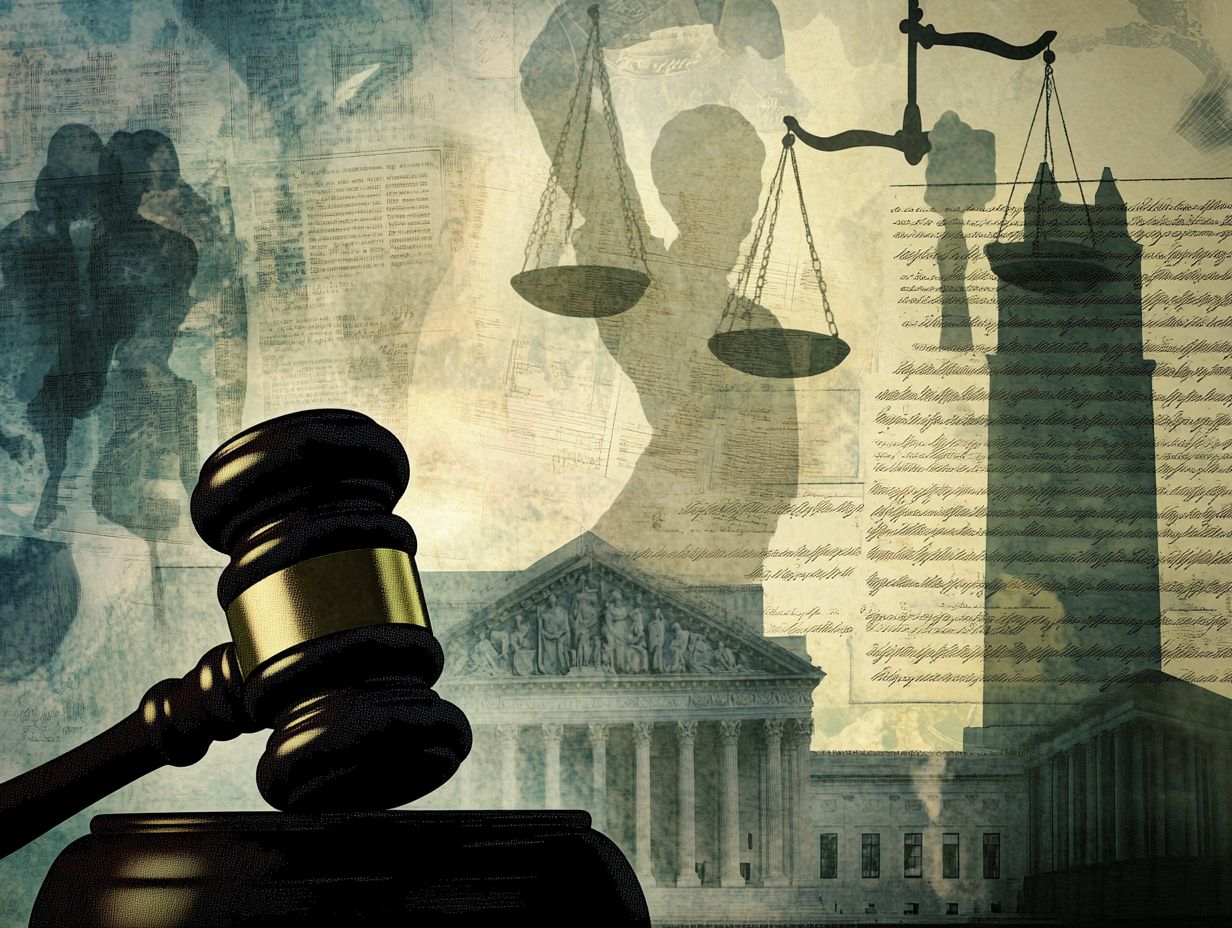
The top 10 landmark cases in IP litigation history are:
- 1. Diamond v. Chakrabarty (1980)
- 2. Sony Corp. v. Universal City Studios (1984)
- 3. Lotus Development Corp. v. Borland Int’l Inc. (1996)
- 4. eBay Inc. v. MercExchange LLC (2006)
- 5. Bilski v. Kappos (2010)
- 6. Alice Corp. v. CLS Bank Int’l (2014)
- 7. Apple Inc. v. Samsung Electronics Co. (2016)
- 8. TC Heartland LLC v. Kraft Foods Group Brands LLC (2017)
- 9. Oil States Energy Services LLC v. Greene’s Energy Group LLC (2018)
- 10. Fourth Estate Public Benefit Corp. v. Wall-Street.com LLC (2019)
What is the significance of the Diamond v. Chakrabarty case in IP litigation history?
The Diamond v. Chakrabarty case, decided in 1980, was a landmark Supreme Court ruling. It established the patentability of genetically modified organisms, allowing patents on artificially created living organisms. This case greatly influenced the development of biotechnology.
How did the Sony Corp. v. Universal City Studios case impact copyright law?
The Sony Corp. v. Universal City Studios case, also known as the Betamax case, established the concept of fair use in copyright law. The court ruled that selling VCRs was not contributory infringement, as long as the device had substantial non-infringing uses. This decision has had a lasting impact on how copyrighted materials are protected and used in the digital age.
What was the main issue in the eBay Inc. v. MercExchange LLC case?
The eBay Inc. v. MercExchange LLC case addressed whether an injunction should automatically be granted in patent infringement cases. The Supreme Court determined that a four-factor test should be applied to decide if an injunction is appropriate, rather than assuming it should always be granted. This decision has greatly influenced the granting of injunctions in patent litigation.
How did the Alice Corp. v. CLS Bank Int’l case impact software patents?
The Alice Corp. v. CLS Bank Int’l case, decided in 2014, set a new standard for determining the patent eligibility of software and business methods. The Supreme Court ruled that abstract ideas implemented on a computer are not patentable. This decision has significantly affected the patentability of software and led to more careful examination of related patent applications.
What was the outcome of the Apple Inc. v. Samsung Electronics Co. case?
The Apple Inc. v. Samsung Electronics Co. case involved patent infringement claims related to smartphone technology. It resulted in a $1.05 billion judgment in favor of Apple. However, the case went through multiple appeals and was eventually settled for a reduced amount. This case highlights the ongoing battles and complexities in IP litigation between tech giants, as discussed in the 5 key takeaways from recent IP litigation cases.
How did the TC Heartland LLC v. Kraft Foods Group Brands LLC case impact patent venue laws?
The TC Heartland LLC v. Kraft Foods Group Brands LLC case, decided in 2017, limited where patent infringement lawsuits could be filed. Now, lawsuits can only be filed in the state where the defendant is incorporated or has a regular and established place of business. This decision narrowed the scope of patent infringement lawsuits and has significantly impacted how these cases are filed.


